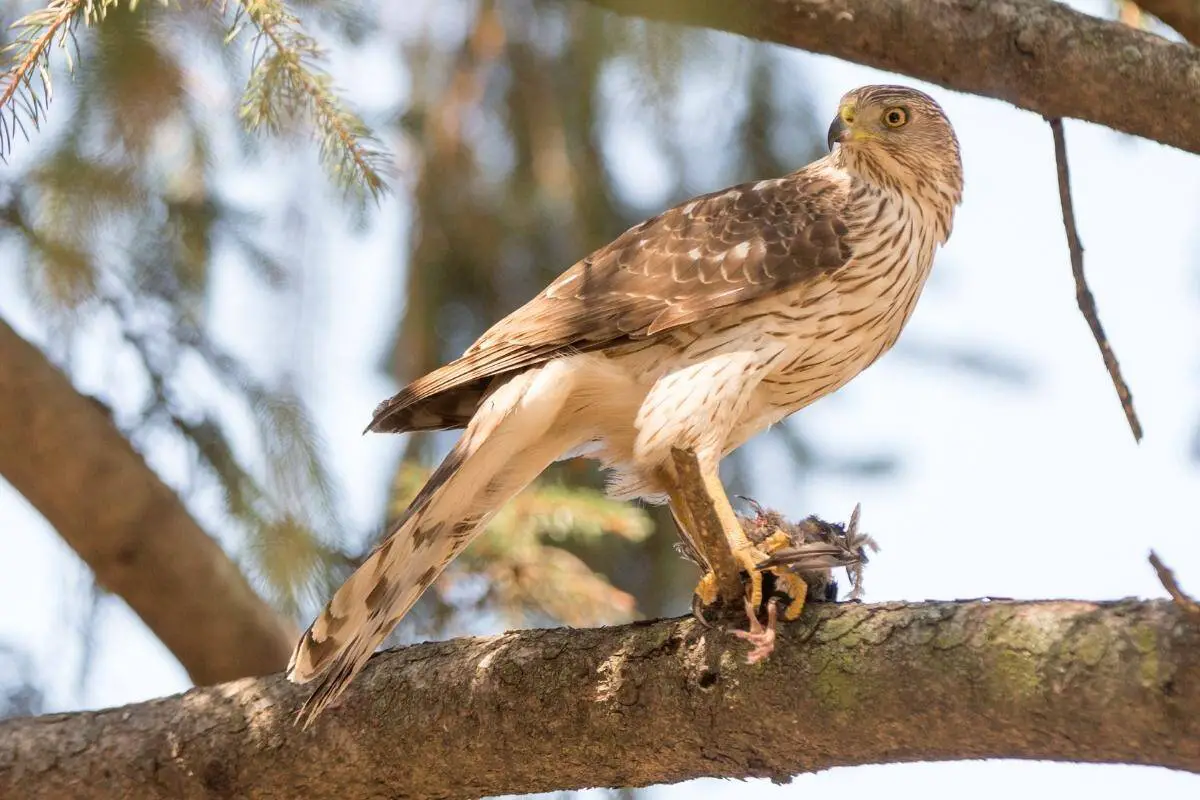
Hawks in Texas
Many diverse species of birds pass through Texas as their migratory routes. As a result, Texas has a diverse hawk population. Even though the world is home to over 200 different hawk species, only 25 of these species are found in the United States. Of these, only 14 species found in Texas are recognized as native to the state.
Table of Contents
Which species of hawk is the most prevalent in Texas?
In Texas and North America, the Red-tailed Hawk is by far the most common of the hawks. These birds are year-round habitant of Texas and most of the United States, except for a small region of the Midwest.
Do raptors live in Texas?
Most diurnal raptors migrate; however, nocturnal raptors spend their entire lives in their primary habitat.
Zone-tailed Hawk
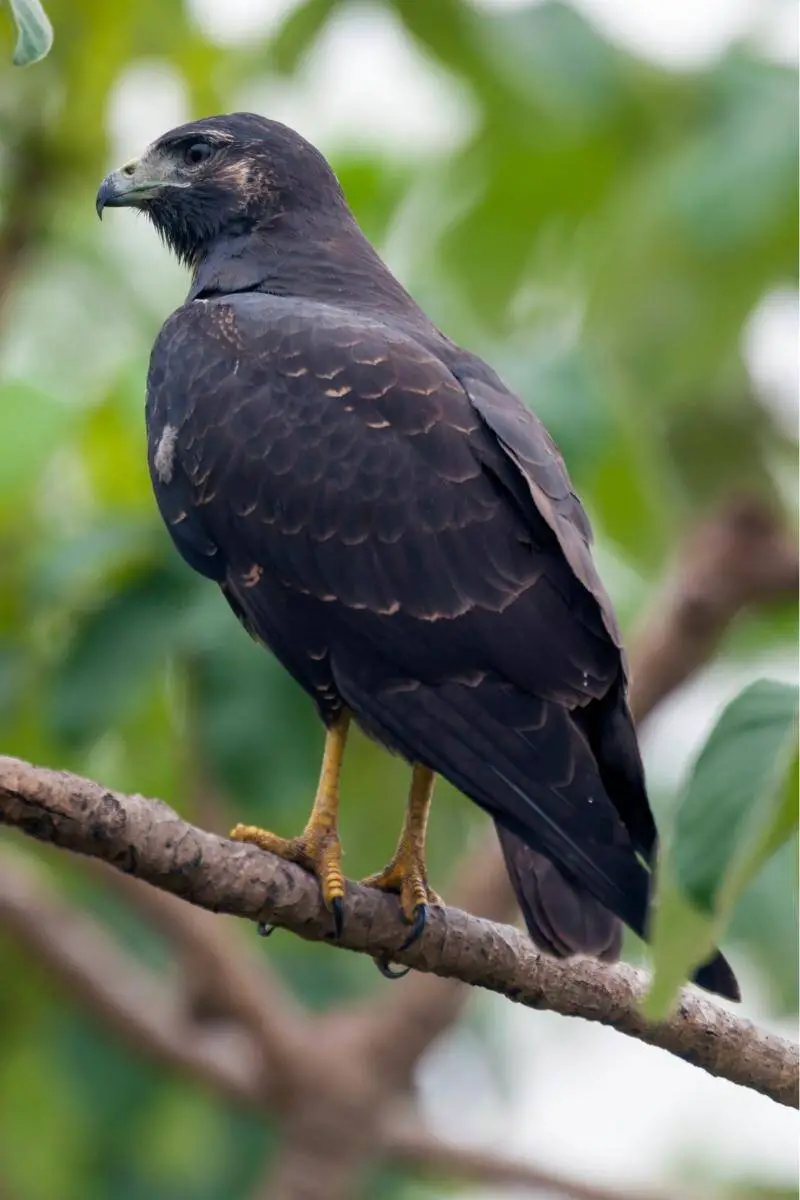
These medium-sized hawks are frequently mistaken for Turkey Vultures because of similar plumage and flying patterns. Both birds fly with their wings slightly lifted and periodically rock back and forth. The Zone-tailed Hawks’ finely banded flight feathers even have a two-toned look, akin to vulture wings. The Zone-tailed Hawks exploit this similarity when hunting because much of their prey considers Turkey Vultures relatively harmless.
The color of the Zone-tailed Hawk is primarily blackish. The cere and legs are yellow. Because the range and ecosystems of the Zone-tailed Hawk and the Common Black-Hawk intersect, the two are easy to confuse. The Zone-tailed Hawk can be identified when they are perched by its slimmer build, longer wings and gray lores (instead of bright yellow), grayish-white tail bands on the dorsum, and shorter legs. The two species look entirely different when flying; the Zone-tailed Hawk has a longer tail and broader wings than the Black-Hawk, making it easier to spot.
Even though the Zone-tailed Hawk breeds in the United States and northern Mexico, it generally moves south for the winter, with a few individuals remaining in southern Texas and Arizona. In the spring, Zone-tailed Hawks come in Texas between mid-March and mid-May, with the majority of them arriving between late March and late April.
These raptors feed on various small vertebrates, including small mammals and birds.
The Northern Goshawk

The Northern Goshawk, a predator of suburban areas and back gardens, is a larger, fiercer, and wilder kin of the Sharp-shinned and Cooper’s Hawks. As an accipiter, it has very short, broad wings and a long rudderlike tail, which makes it highly agile in the air. It’s a fascinating bird. These secretive birds are grey but have prominent white “eyebrow” strands across the tops of their sharp orange or red eyes. The coloration of an immature northern goshawk differs significantly from that of an adult. They have brown backs, wings, heads, and a white bottom part with brown streaking down the center.
The Northern Goshawk is the most commonly spread Accipiter, appearing on all five continents. These hawks can be found all over North America and Eurasia’s mountainous regions and forests but not in the south-eastern US. Boreal forests, northern hardwood forests, and pine estates are all used by Northern Goshawks as their primary habitat. Although the United States and Canada population is seemingly stable, Goshawks are vulnerable to habitat destruction due to deforestation and separation in their native range.
Goshawks build their nests on horizontal branches in forks or near the trunks of the largest trees in a fully developed forest with large trees, an open understory, and little vegetation. On average, a pair will have one to eight nesting sites spread out across their territory. Although goshawks occasionally use the same nest year after year, they are more likely to use different nests every time they reproduce.
Small to medium-sized mammals and medium- and large-sized birds from forest, edge, and scrub habitats are among essential prey for Northern Goshawks. These hawks fly across forested areas to pursue birds and mammals, bearing down quietly or plunging feet first through the underbrush to catch quarry with cripplingly powerful talons. They’ll also go after fish, amphibians, and insects.
The Northern Harrier
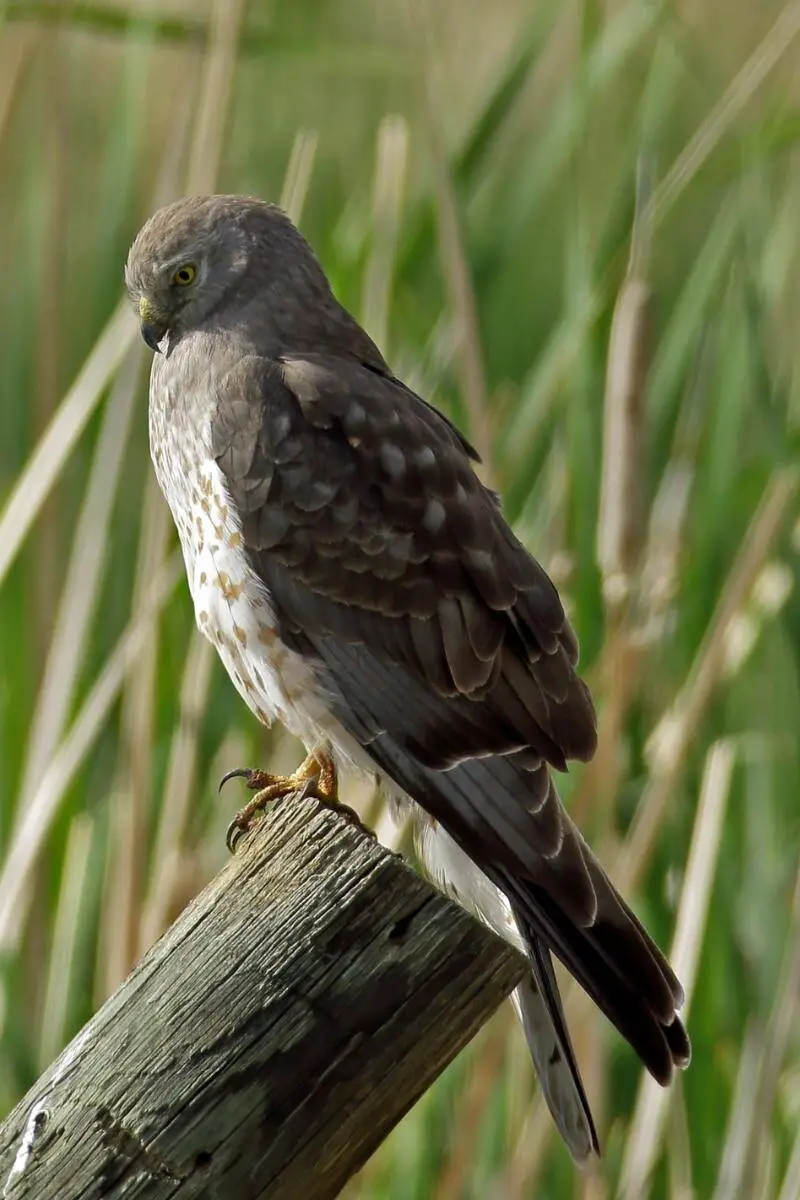
The Northern Harrier is easily recognized by its beautiful and strategic flying over farms, meadows, and marshes. While hunting, harriers have a characteristic flight pattern with a conspicuously large tail and long wingspan held in a dihedral, and they swoop low to the ground. The unique white upper tail coverts add to the visual indications for the bird’s identification. However, a few other raptors have white color on their tails or upper coverts and can commonly be mistaken for the Harrier. Therefore, the flight characteristics of the Northern Harrier are far more accurate in distinguishing them.
The Northern Harrier may be found all year in the southern United States’ milder climates, but the higher areas are forsaken in the winter. Nesting birds in more northern places travel to the southernmost United States, Mexico, and Central America in the winter. Prairies, open spaces, and wetlands are all home to this bird.
Northern Harriers, unlike other hawks, hunt mainly by sound. Because it’s easier to hear rodents in the grass if they’re close by, Harriers are virtually always spotted flying closer to the ground. Mammals, rodents, and birds make up their principal targets.
The females of this bird are more frequent than males, and their brown color distinguishes them. On the other hand, males are gray and are known as “Gray Ghosts” for their ability to glide quietly back and forth through the air.
The White-tailed Hawk
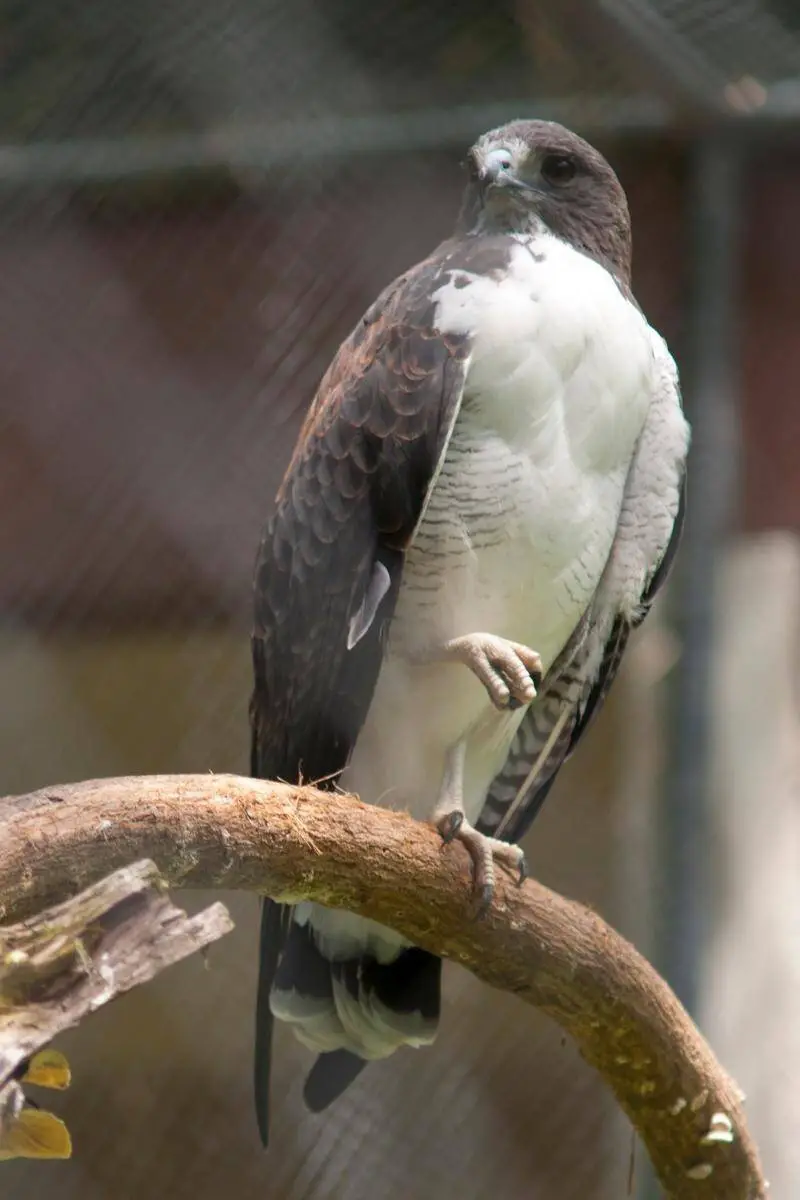
White-tailed Hawks can be seen year-round in southern Texas’s grasslands, prairies, savannas, and pastures. Other regions they inhabit include much of Mexico, some parts of Central America, the southern Caribbean, and open environments in most South American countries. This variety is rare in farmland and pastures unless there is a fire. White-tailed Hawks (particularly immature) flock to prairie fires to capture rodents and other animals escaping the blaze.
The White-tailed Hawk’s nutrition changes depending on its surroundings. In southern Texas, rabbits constitute most of the bird’s food, but lizards are the favored target in the Dutch West Indies. When looking for their prey, it frequently lingers, and it will capitalize on wildfires to grab creatures fleeing the flames. White-tailed Hawks sit on power lines, shrubs, and small trees when they are not searching for food. Mammals, birds, reptiles, amphibians, insects, and other arthropods are all eaten by White-tailed Hawks. Hunting usually takes place from ledges and can begin from dawn and last until dusk.
The adult White-tailed Hawks are gray on the upper parts, white underneath, with a rump featuring pale gray or reddish striping. The wings seem dark above the black main remiges, with gray admixed immediately beneath. The bird has a rusted shoulder patch when it rests with its wings folded. The distinctive brilliant white tail with a black band is a dramatic pattern against a blue sky.
Gray Hawks
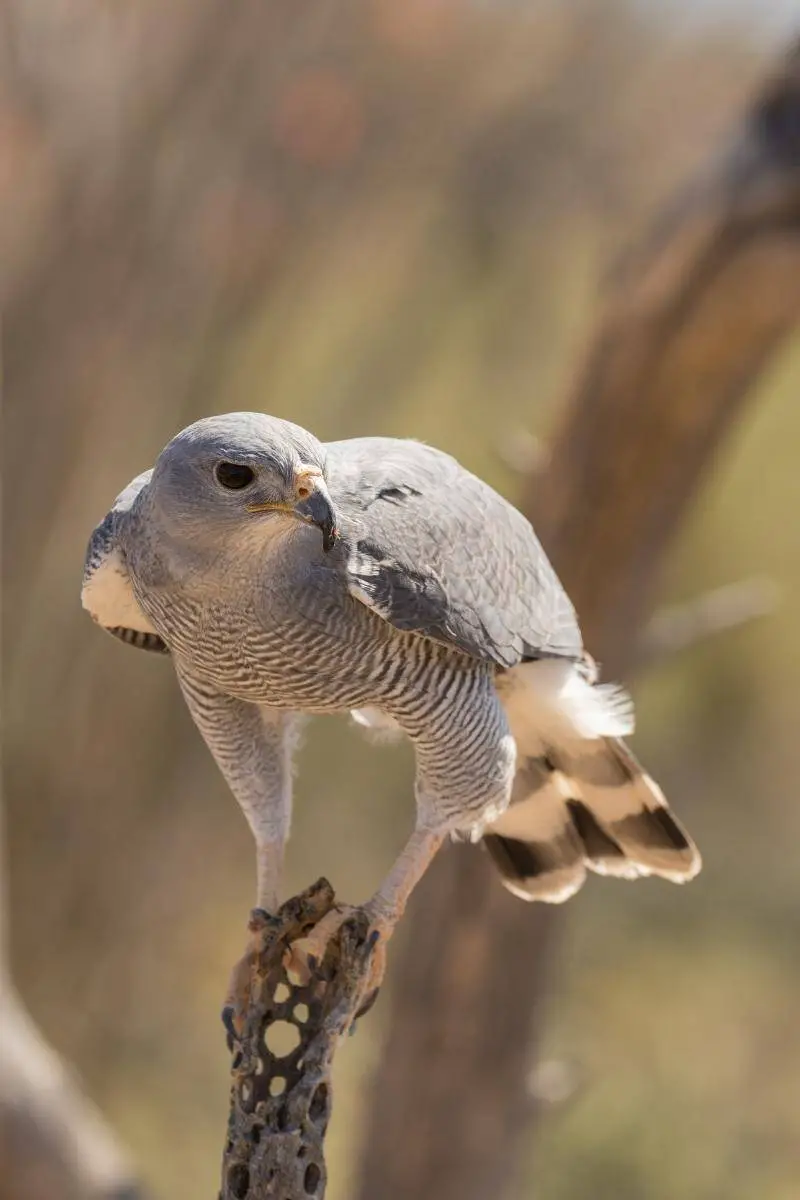
Gray Hawks have a minimal range in the United States. Gray Hawks are difficult to see when they are present since they perch patiently in trees searching for prey. Monitoring their calls is the best way to locate them. To find partners and identify territories, males usually employ a 3-note whistle, known as a “kah-lee-oh.”
While the sexes of the Gray Hawks look similar, the female is noticeably larger. These birds are light grey, with little bars running the length of their breasts; their wings are lightly patterned, and their long tails have three dark bands running the length of them, offset by four light bands. The breasts are thickly speckled, and the face is entirely white with bold eye lines. The young Gray Hawks have a brown back, wings, and a banded tail, distinguishing them from adults.
This hawk’s travel patterns are determined by where they reside. Migration is typical among birds living in northern Mexico and the southwest United States. Birds in the southern United States tend to remain in one place year-round. Only a few birds from the northern range of the species choose to spend the entire year in the southern region of Texas instead of migrating. Once the breeding season is through in mid-October, the species will start the long trip south to their wintering grounds.
For the most part, just one breeding effort is made each year. The nest, built by both sexes, is made of twigs and may contain some greenery. The green leaves that line the cup are made by breaking live, leafy twigs from trees. This species’ eggs are typically white or pale blue-white with no markings, and the female incubates them for 32-34 days. While only the females are responsible for hatching, the males are responsible for providing food for the females.
Red-shouldered hawks
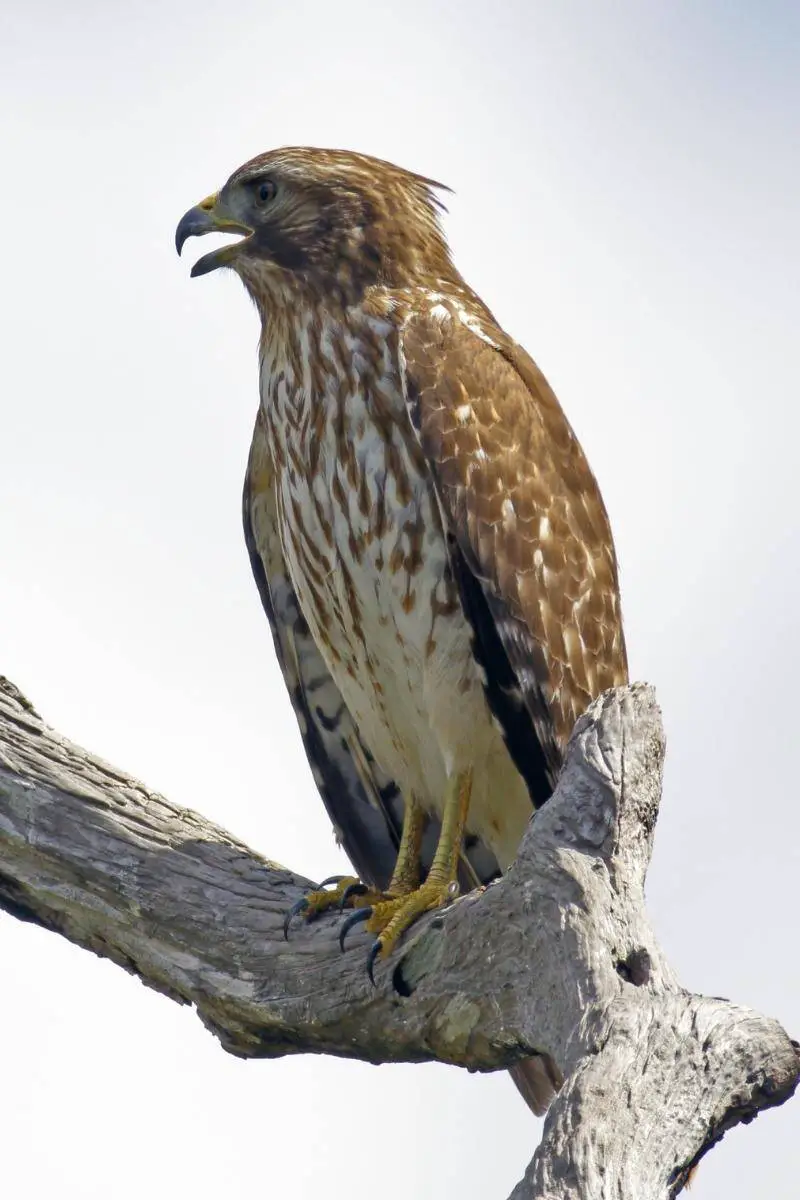
Red-shouldered hawks are red-brown birds with long, tightly barred undersides. Although widespread in eastern and Pacific North America, these birds face the threat of long-term survival due to habitat loss. While most of its range is occupied by year-round residents, the northern birds are migratory, usually to central Mexico. In Texas, the Red-shouldered hawks are found in the southern and eastern regions.
A large part of their habitat consists of uplands, fragmented forests, smaller forests, open spaces, and edges. The Red-shouldered hawks breed in swamps, open pine forests, riverine forests, and swamp edges in the California coast, eastern North America, and northern and northeastern Mexico. Red-shouldered hawks’ habitat use is less restricted during the non-breeding period.
The Red-shouldered hawks compete with the slightly bigger red-tailed hawks for nesting sites. As a result, there is a possibility that they are forced into closed canopy woods where the red-tailed hawk doesn’t nest.
The Sharp-shinned Hawk
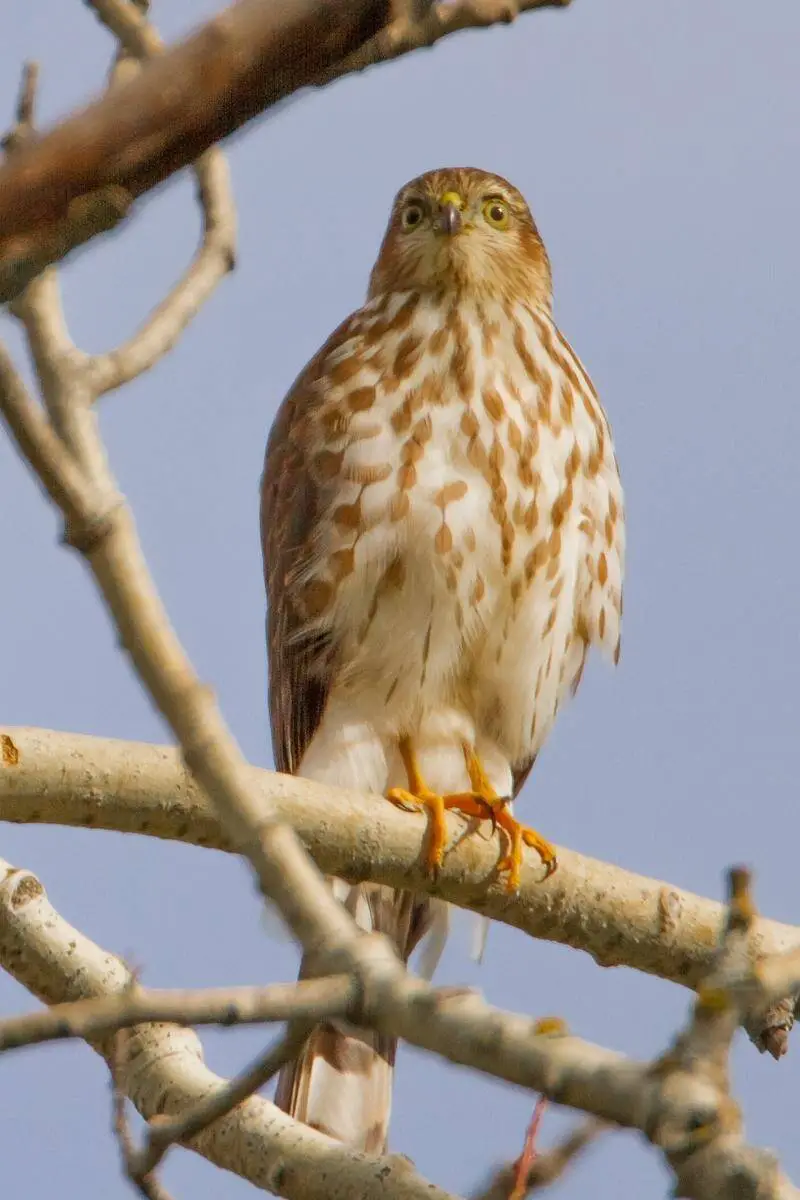
Across the United States, southern and western Canada, Mexico, and Central America, sharp-shinned hawks are prevalent in lowland woodlands and open spaces. These birds can be sighted in the urban and suburban parks and urbanized regions with some trees. A migratory bird, these hawks move between their breeding and wintering sites, sometimes covering considerable distances in a single trip. It appears that some birds in the Pacific Northwest winter there permanently; however, this is not always the case.
The Sharp-shinned male hawk is North America’s tiniest hawk. These hawks are purely avian predators that feed on small birds like doves and quail; they frequent bird feeders to feed on birds, not the seed. They are known to chase songbirds through the thorniest of thickets and emerge unscathed. When hunting, it stalks its prey silently until it is within striking distance before quickly bursting forward. Their brief burst of high-speed flying and long, sharp claws help them seize their prey. The Sharp-shinned hawk doesn’t need to drink water as they get all their hydration from their mark.
Sharp-shinned hawks assemble in their mating grounds from April to early May and begin bonding with their mates. These birds are monogamous, and the males have high territory fidelity. However, from one year to the next, a pair will use a different nest. Females use newly broken twigs to build their nests and then line them with bark. They frequently build their nest right up against a mature tree’s trunk. During the 30-32-day incubation period, the female lays the eggs while the male brings food to the nest. In the middle of May, the female will lay a clutch of 4-5 eggs. The eggs range in color from off-white to bluish-white with brown spots.
Cooper’s Hawks
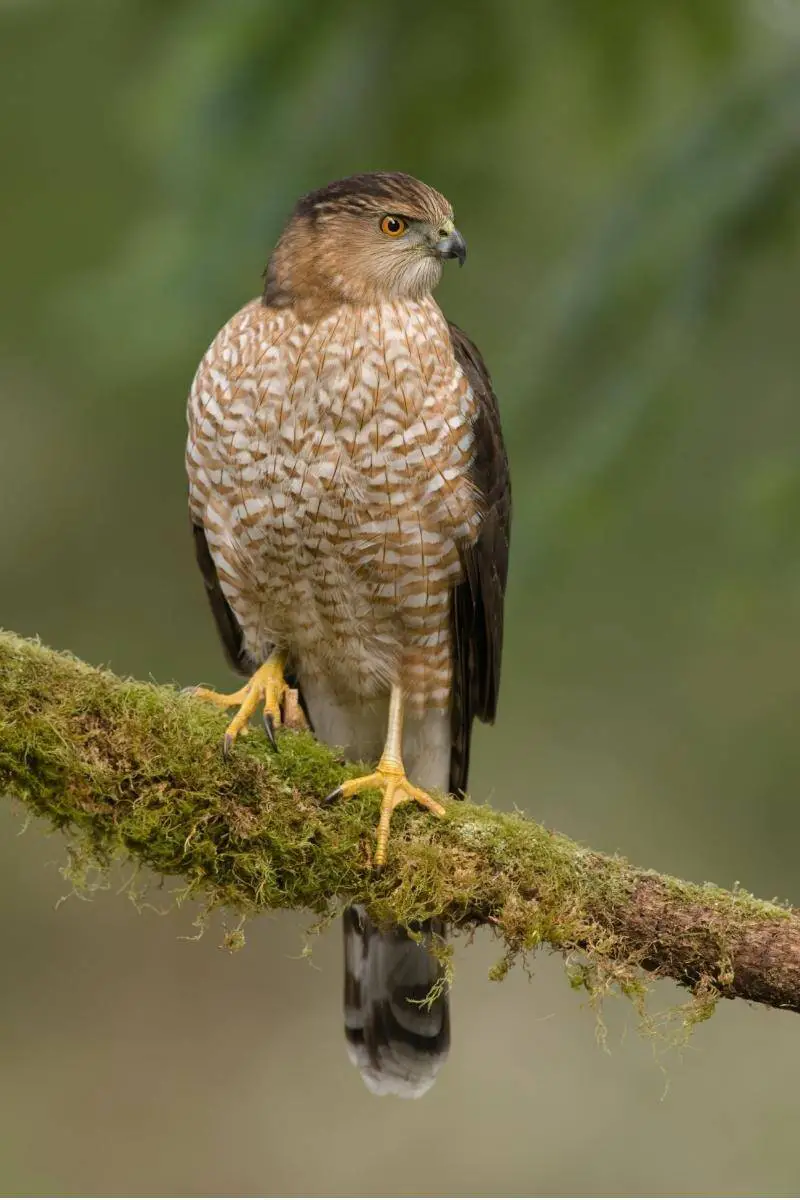
Cooper’s hawks, a medium-sized raptor native to North and South America, can be found in many places. When prey is difficult to come by during the winter, birds in the northern half of their range travel to warmer places to obtain food. Some of these hawks have also been observed migrating down to Honduras and Colombia.
Breeding occurs from southern Canada up to northern Mexico. Forests with deciduous and mixed trees are home to Cooper’s hawks. Aside from dense forests, they also inhabit open woodland settings such as wooded areas or riparian forests in the southwest United States and other parts.
Cooper’s hawk’s adults have red eyes, and they wear an orange hat. They can be identified by their dark blackish heads separated by a white nape on the adults. On the back, they are blue-gray, and on the tail, multiple black bands cross over each other, with a white band at the tip. As is common among raptors, the male is smaller than the female. Cooper’s hawks have a long, banded tail and short, rounded wings when in flight. The combination of their long tails and short wings makes these birds extremely agile in dense woodland. Birdwatchers say they look like a flying cross when they are in flight because of their long necks.
Because of their territorial nature, Cooper’s hawks can be violent toward other raptors, especially sharp-shinned hawks. They’re very violent at nesting sites and will dive at people who get too close, even if they’re not attacking. Generally, Cooper’s Hawks eat medium-sized birds and small mammals, but they will also eat insects, frogs, and reptiles while they are out in the wild. While other raptors use their claws and teeth to snag their prey, Cooper’s hawks continuously use their feet to crush their prey into submission.
Harris’s Hawks
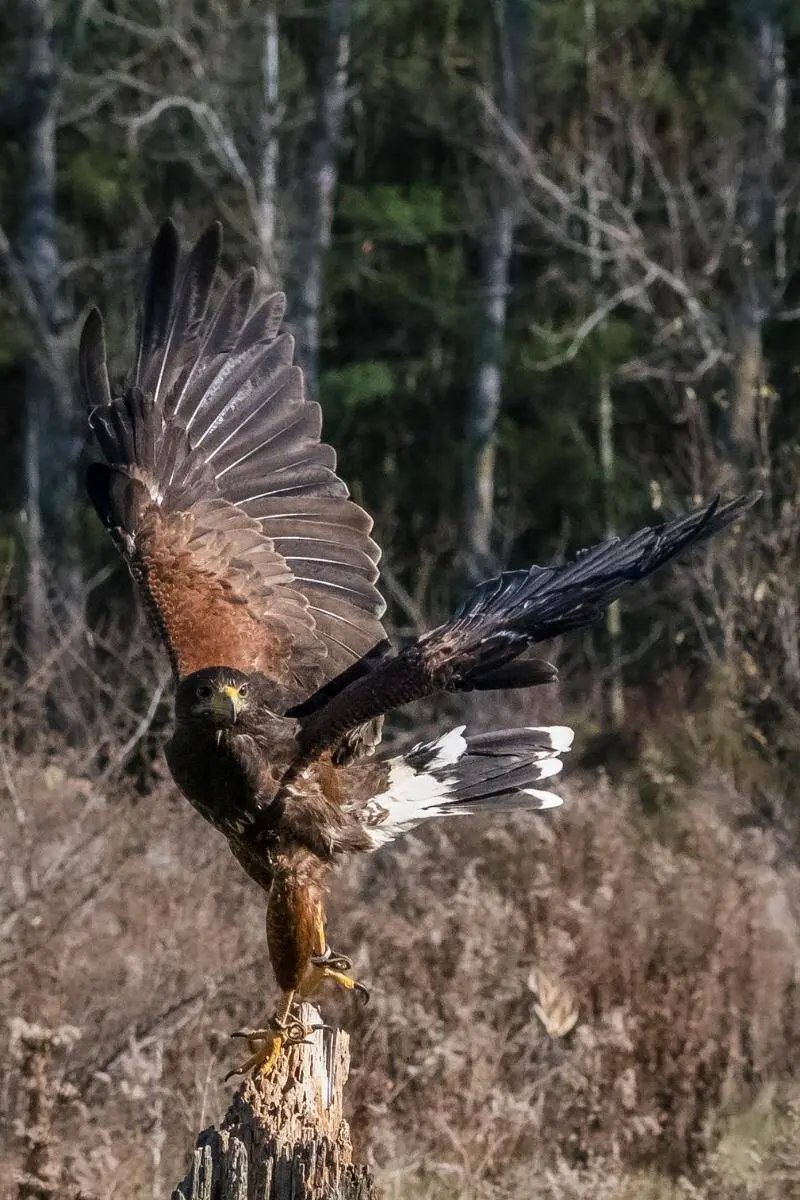
The Harris’ hawks inhabit various environments, including sparse woodland, semi-desert, savannah, shrubland, and even marshes. The coloration of the sexes is nearly identical. Chestnut-colored wings and thighs with a white tip to the tail complete the dark brown plumage of this bird. It also has long, yellow legs and a yellow cere on its head. Males are smaller than females.
A structure of supremacy exists in Harris’ hawks: the mature female is in charge, followed by the adult male, and finally by the young from previous years. There are usually 2 to 7 birds in a group, and they work together in many ways, including hunting and nesting. Nests are built in cacti, trees, bushes, or artificial structures. Female Harris’ hawks use the same nest year after year. Females may lay a second or even third clutch if food is plentiful in the area.
Their hunting style is similar to that of mammals; some group members will flush out the prey, which the other hunters chase. No other raptor has been observed hunting in such large groups as this one. Thanks to their unusually collaborative hunting behavior for raptors, they’ve earned the moniker “Wolves of the Sky.”
These hawks are active in the early morning and late evening. When on the prowl, they fly low and fast through the brush, avoiding cacti and bushes along the way. Individual Harris’s hawks catch small prey like rodents, birds, and lizards. When hunting larger prey like jackrabbits or turkeys, two or more hunters will work together to bring their target down. They’ll alternate chasing until the target is too exhausted to continue running.
Rough-legged Hawks
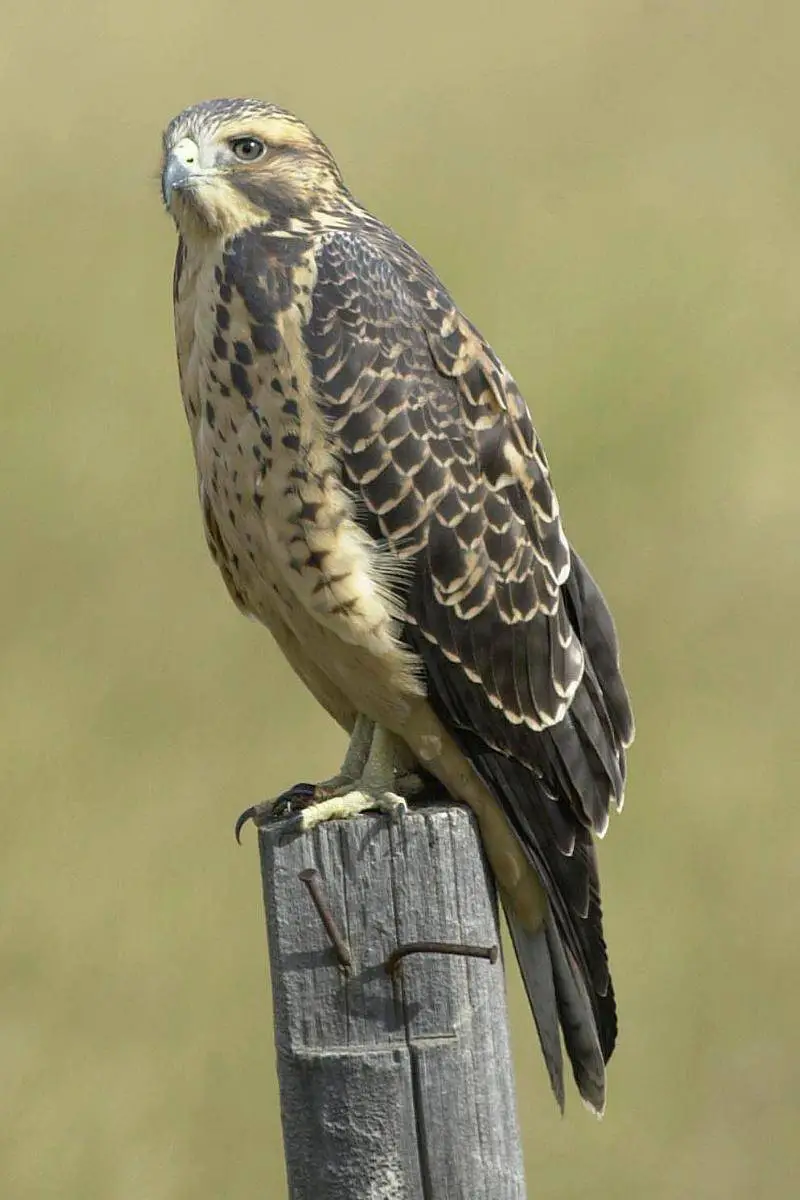
During the mating season, the Rough-legged hawk can be found in the Arctic and Subarctic regions of North America and Eurasia. They spend the winter in open areas such as prairies, farms, and marshes across southern Canada and the United States. During the Rough-legged hawk’s mating season, lemmings are an essential source of nutrition. In the wintertime, they have been observed to consume carrion. At other seasons of the year, the diet includes voles, mice, ground squirrels, and other small mammals.
The most common sightings are of a single or a pair of Rough-legged hawk; significant groupings are pretty uncommon. These hawks prey over the vast ground. The Rough-legged hawk will fly low over the ground or linger high over a field from a perch, keeping an eye out for activity before diving down and grabbing prey with their claws. Along with kestrels, kites, and osprey, they are the only other raptors that habitually hover. The Rough-legged Hawks can also balance on a thin ledge because of their short feet. Small mammals are their primary diet.
Rough-legged hawk males and females collaborate to construct a nest on a rock outcrop. Most bird nests can be found in trees or on cliffs. Females assemble the nest using twigs, grass, molted feathers, and fur from the prey, while males transport most of the material. Nests have been seen to contain even the bones of caribou. Although clutch sizes vary depending on the food available, three to five eggs are the norm.
The Ferruginous Hawk
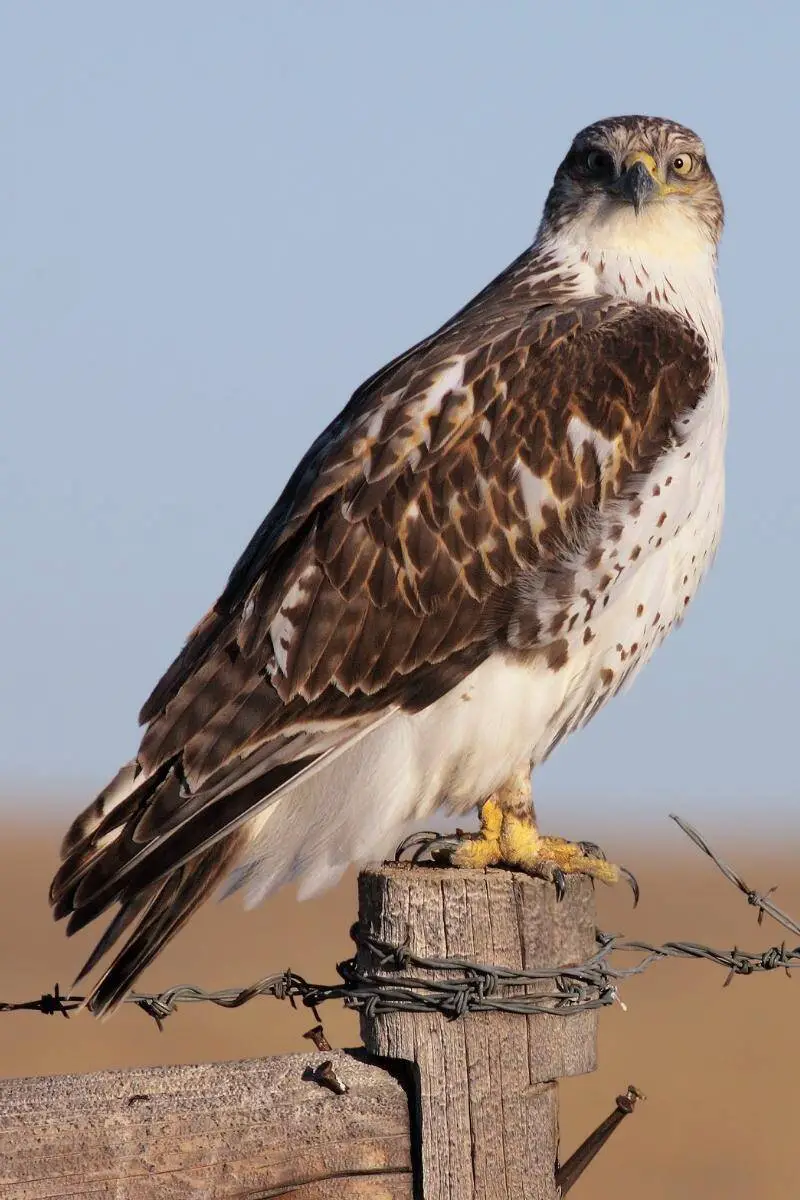
Ferruginous Hawks, North America’s largest hawk, have a distinctive huge gray head, rusty shoulders and legs, and sparkling white lower parts. Despite their ferruginous (rust) appearance, these hawks come in two distinct color varieties. In the light variant, the head and breasts are pale gray with a rufous striping. The thighs and wings are rust-colored with grey and rufous patterns. Individuals of the dark morph have a dark appearance all over. The reddish-chocolate coloration of a darker morph is extremely rare. Due to its large bill and long yellow gape, the Ferruginous Hawk has a more eagle-like appearance than other buteos. The large gape may improve the bird’s ability to regulate its body temperature by panting more effectively, a valuable trait for wildlife living in hot, open areas.
Ferruginous Hawk hunts from a lone tree, rock outcrop, or a great height in the West’s prairies, deserts, and open range. These birds feed on prairie dogs, ground squirrels, and other small mammals. When hunting these animals, they will stand above burrows to watch for their prey to come out of hiding.
A large part of its range is in southern Canada, the south-eastern United States, and northwestern Mexico. In contrast to the Broad-winged Hawk, this hawk migrates across very short distances, mainly between the Canadian and American continents.
Ferruginous hawks begin reproducing at the age of two. In a nest built in a shrub, a tree, or hillside, a female will lay a clutch of 3-5 eggs. Both parents incubate the eggs for 28 to 36 days before they hatch. After about 38 to 50 days, a chick can leave the nest. Although female Ferruginous chicks might take longer to develop, they grow to be larger than the males.
The Red-tailed Hawk
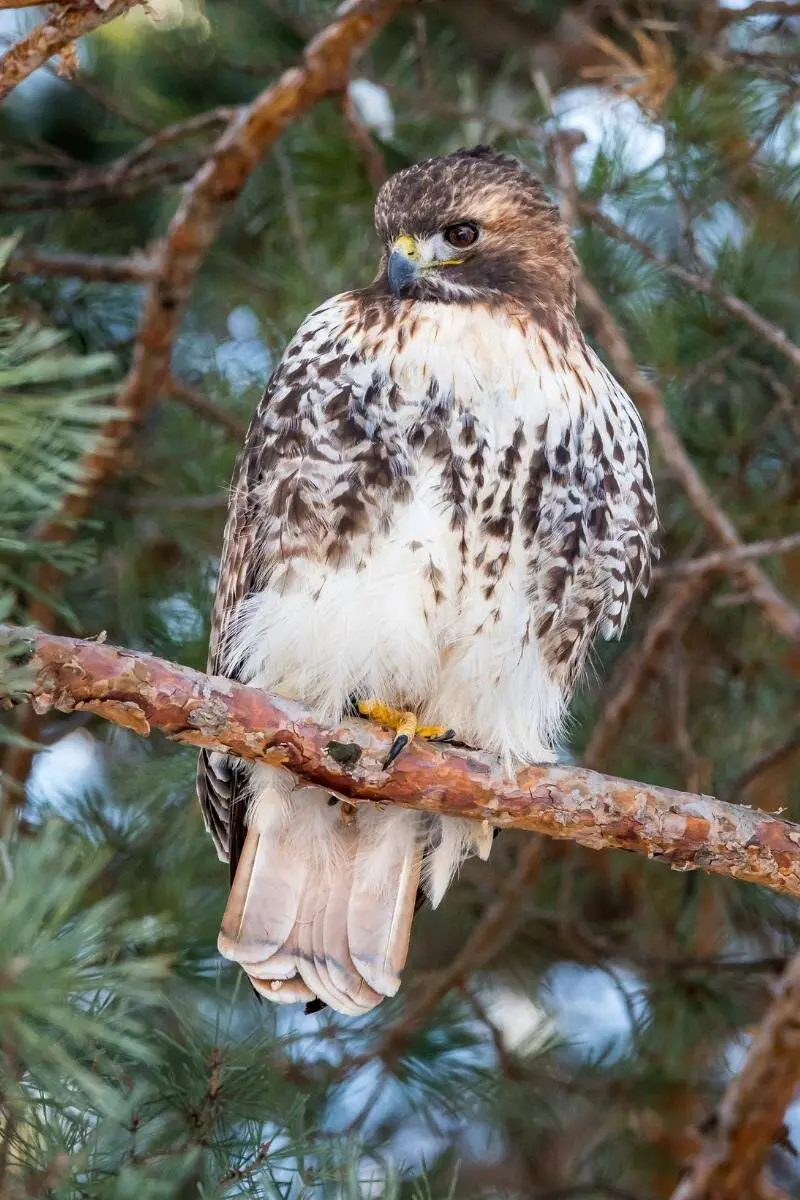
Texas is home to a large population of Red-tailed Hawks, which nest in a range of habitats. In North America, these birds are protected under the Migratory Bird. However, Red-tailed Hawks still face numerous dangers, just like many other bird species; some people kill or capture them to keep them as pets in parts of their range.
Individuals of the red-tailed hawk species exhibit a wide range of coloration and patterning. For the most part, the females are larger than their male counterparts. These hawks are excellent flyers and can stay immobile in the air without flapping their wings or use thermals to soar for extended periods.
While waiting for prey to approach, they inspect the area from high perches, using a sit-and-wait strategy. The bird’s keen vision allows it to spot prey on the ground even when flying at great altitudes. The beak of the red-tailed hawk is sharp and curved, and it is used to tear prey apart for consumption
Red-tailed Hawks build their nests in tall trees, often the tallest tree in an area. These hawks also nest in towers, nest platforms, and buildings. A pair of birds build a stick nest which they re-use in subsequent seasons. The birds of this species are known to have long-term relationships with their partners.
Swainson’s Hawks
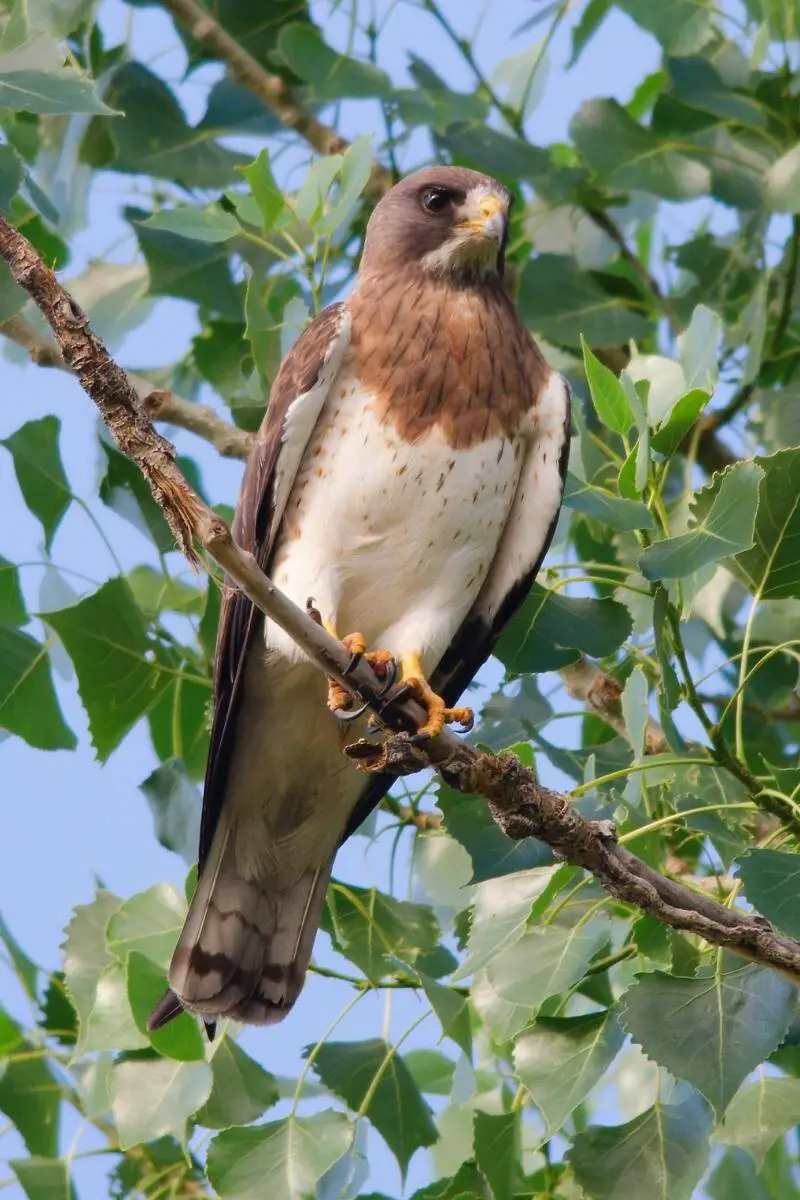
Swainson’s Hawks are large hawks with relatively broad wings and short tails. In comparison to other species of their family, Swainson’s Hawks aren’t as large. They hold their wings in a shallow V when flying high, giving them a slimmer, more extended appearance.
Swainson’s hawks are long-distance migratory birds that nest primarily in lone trees in open grassland areas. This species of hawk spends winter on the pampas of South America in Argentina, Uruguay, and southern Brazil. However, a small proportion of these birds spend the winter in Florida’s south-eastern coast and along the coast of Texas. Likely, they do so because they could not make it down the coast around the Gulf. Migration may take two months or longer to complete each time.
Since Swainson’s hawk population has declined due to habitat loss, state and federal agencies have designated it a Species of Concern (SOC). The ability of the landscape to support breeding pairs reduces as essential foraging regions are transformed into urban landscapes or other unsuitable habitats. Herbicide toxicity and climate change are additional dangers that the Swainson’s Hawks face.
The dive may end with a dramatic ascent to a perch. Swainson’s hawks are found throughout much of the central and western United States and Canada, which has led to many research studies on the birds’ reproductive processes.
The Broad-winged Hawk
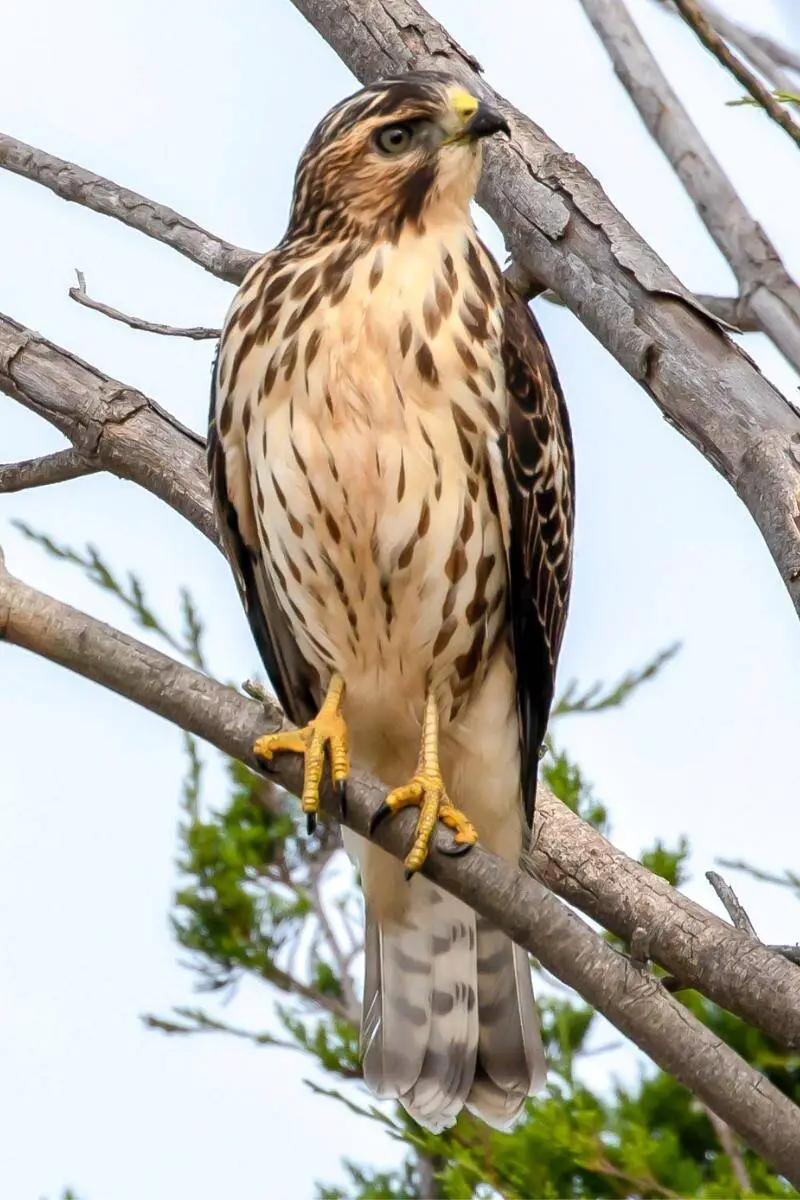
Broad-winged hawks are small, compact birds with hefty bodies and large heads. A short, thick, and square tail accompany the body. Their broad wings taper to a tip when they’re flying. The dark brown adult bird has a white belly and chest with horizontal barring, and it’s around 18 inches long. The immature hawks are distinguishable by a white longitudinal barring. Female falcons are slightly larger than males. Broad-winged hawks have two morphs; the rare dark variant with few white spots and a light more that is pale all over.
An estimated one million birds make up the North American population of this hawk, making it one of the most widespread raptors. They can be found all over eastern and northeastern North America, from Texas to Minnesota, and even in the northwest. Only small numbers inhabit British Columbia. Several Caribbean islands have indigenous subspecies that live there all year. This species is uncommon in open areas, and it’s pretty rare across its breeding region.
The broad-winged hawk is a versatile hunter who feeds on everything from amphibians, reptiles to young birds. During the nesting season, fish and crustaceans are the primary prey. During their long-distance migration, large insects serve as an essential prey item. Adults tend to become more active hunters in the late morning hours. Before eating, they de-feather birds and remove the skins of frogs and snakes.
In addition to communicating with their partners and young, red-tailed hawks utilize vocalization to mark their territory. They have a call that sounds like a whistle or a very high-pitched kee-ee. When they sense danger, an alarm sound made up of stuttering and screeching whistles are used.

